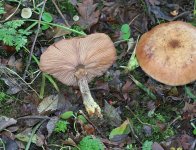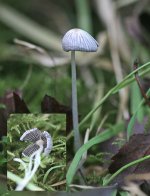27.11.06: Since originall posting this message yesterday I have managed to id two out of the three!
Just leaves one - could it be Tricholomopsis Rutilans (Plums and Custard)
"I am new to fungi and have recenty bought reference books by Phillips and by Jordan. Yet I cannot manage to id any of the following which I thought would be straight forward. Taken in south Notts.
"There were quite a few of these on the edge of a path. I have just noticed two small bonnets in the picture as well!
Any help appreciated.
Thanks
Richard
Just leaves one - could it be Tricholomopsis Rutilans (Plums and Custard)
"I am new to fungi and have recenty bought reference books by Phillips and by Jordan. Yet I cannot manage to id any of the following which I thought would be straight forward. Taken in south Notts.
"There were quite a few of these on the edge of a path. I have just noticed two small bonnets in the picture as well!
Any help appreciated.
Thanks
Richard
Attachments
Last edited:





